Key takeaways:
- Understanding and respect are essential for fostering harmony in interfaith family dynamics, allowing for open discussions about beliefs and traditions.
- Religious education not only shapes personal beliefs but also encourages dialogue within families, helping future generations appreciate diversity.
- Creating inclusive practices, such as a family celebration calendar and cultural dish nights, strengthens connections and fosters a sense of belonging.
- Navigating challenges in interfaith families involves open communication and finding common ground to respect both faiths while nurturing a rich family heritage.
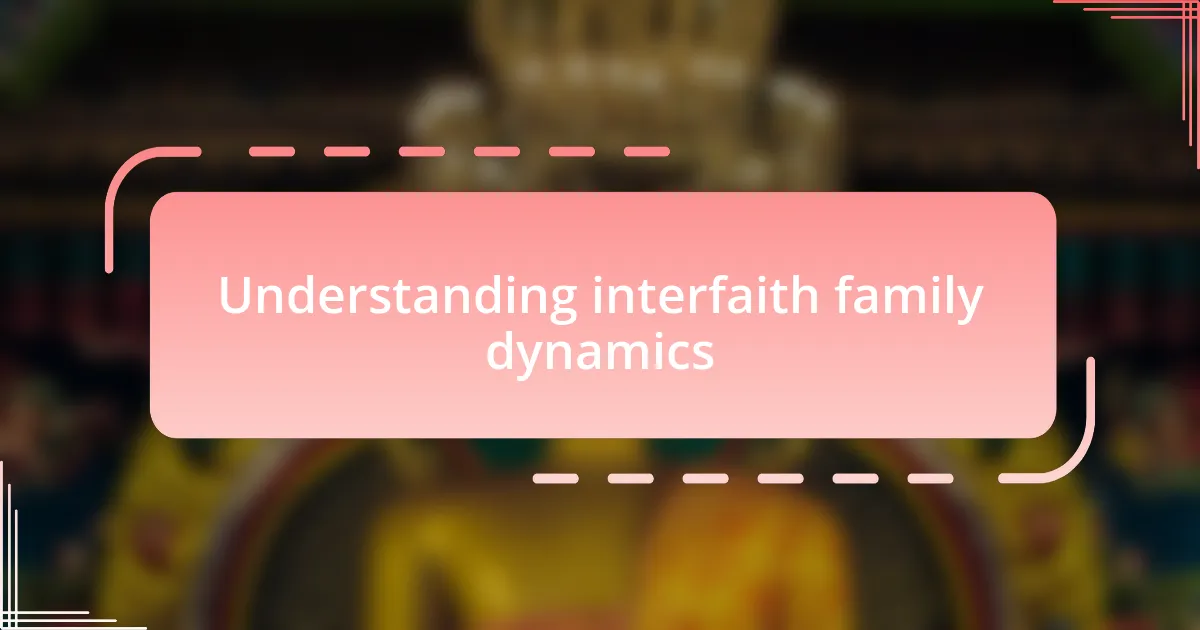
Understanding interfaith family dynamics
Navigating the intricate world of interfaith family dynamics can be both challenging and enriching. I remember a moment when my family gathered for a holiday meal, and the conversation swiftly shifted from the joys of shared traditions to the nuances of differing beliefs. It dawned on me then how pivotal understanding and respect are in creating harmony amidst diversity.
One striking realization I had was that each belief system carries its own emotional weight—whether it be joy, grief, or reverence. I often found myself reflecting: how can we celebrate our differences while fostering a sense of unity? By openly discussing our traditions and listening to one another’s stories, we grounded ourselves in a shared experience that transcended simple tolerance.
In my experience, those moments of vulnerability, where we expressed our fears and hopes, became the cornerstone of our familial bonds. The warmth that grew from those dialogues not only deepened our relationships but also cultivated a safe space for future generations to thrive amidst the richness of their mixed heritage. How can we encourage such open conversations in our families? It all starts with a willingness to listen and learn from one another.
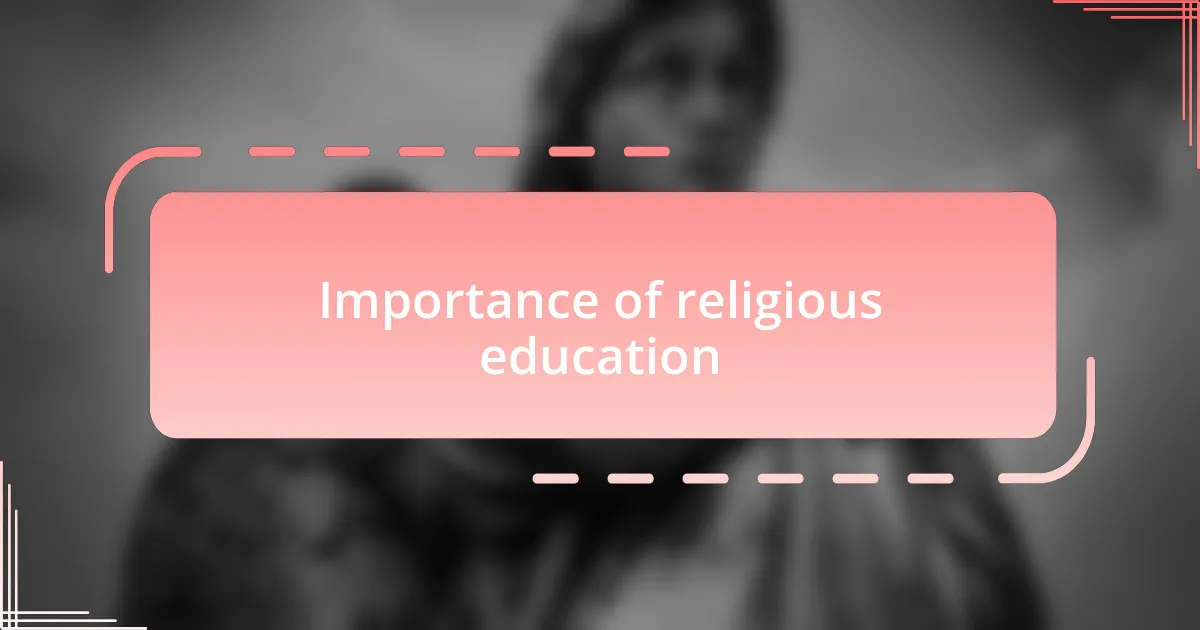
Importance of religious education
Religious education plays a crucial role in helping individuals navigate their beliefs and values. I often think back to my own childhood experiences in diverse religious settings. Learning about various faiths not only gave me insight into others but also helped me solidify my own beliefs, creating a strong foundation that I carry with me today.
Consider how it shapes the moral compass of a person; during discussions in religious classes, I vividly remember grappling with ethical dilemmas often found in sacred texts. It struck me that these discussions were not just academic—they were intimately tied to my everyday decisions and interactions. How can we expect future generations to understand compassion and respect without this foundational knowledge?
Additionally, religious education fosters dialogue within families, especially in interfaith contexts. I recall a Thanksgiving dinner where we shared stories from our respective traditions. Having educated ourselves about each other’s beliefs allowed for heartfelt conversations and deeper connections. Isn’t it empowering when education transforms potential conflict into understanding? This kind of learning ensures that our children grow up appreciating diversity rather than fearing it.
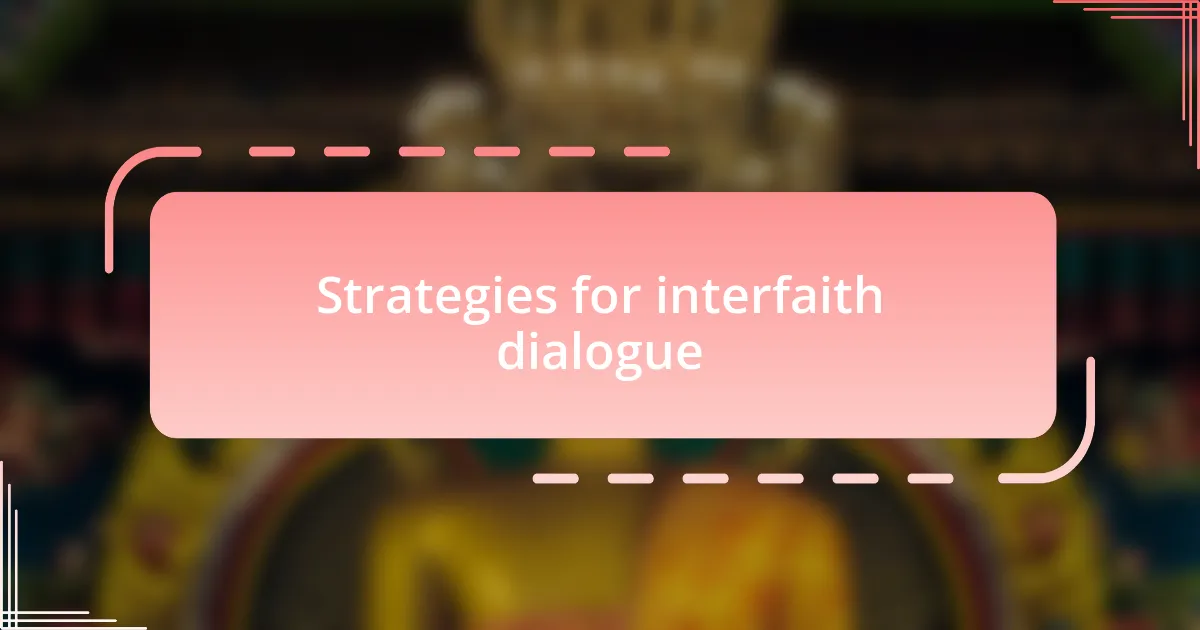
Strategies for interfaith dialogue
Open communication is key when navigating interfaith dialogue. I remember a family gathering where we intentionally set aside time to discuss our differing beliefs. By creating a space where everyone felt safe to share, we not only deepened our understanding but also fostered respect for each other’s perspectives. How can we find common ground if we don’t first listen?
Active listening plays an equally important role. I learned that sometimes, just hearing someone out can be more impactful than responding immediately. During a tense conversation about traditions, pausing to reflect before replying changed the entire dynamic. It shifted our focus from defending our beliefs to exploring them together. Isn’t it interesting how silence can lead to so much more clarity?
Finally, finding shared values can bridge gaps between faiths. I often reflect on my experiences volunteering with both Christian and Jewish communities. Working alongside individuals who hold different beliefs but share the same desire to help others reinforced my belief that at our core, we often want the same things. How powerful is it to see that, despite our different paths, we can still walk together?
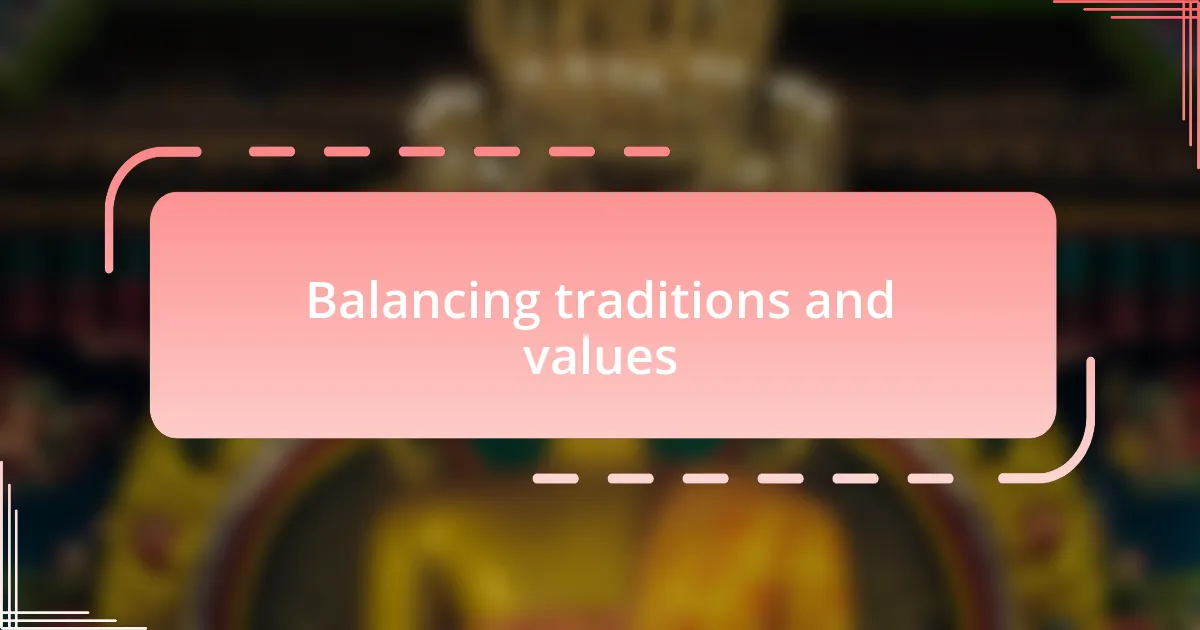
Balancing traditions and values
Navigating the delicate dance of traditions and values in an interfaith family can be a rewarding yet challenging experience. I recall the first time we blended holiday celebrations, where we lit the menorah for Hanukkah just before setting up the Christmas tree. The joy on my children’s faces as they embraced both traditions reminded me that it’s not about choosing one over the other; it’s about celebrating the richness each brings. How can we not celebrate the beautiful tapestry of our lives?
In the early stages of our family journey, we faced tension around certain rituals, particularly during major life events like weddings or funerals. I vividly remember a family discussion about how to honor both faiths in a wedding ceremony. The compromise we reached not only incorporated elements from each tradition but also resonated with our shared values of love and commitment. This taught me that finding a middle ground can solidify connections rather than fragment them. Isn’t it fascinating how compromises can create new traditions?
One essential realization I came to was the importance of teaching our children about both cultures. I found that sharing stories about my own experiences with faith helped them appreciate where we come from while allowing them their own exploration. It’s a balance of guiding them through our family values while giving them the freedom to ask questions and seek their own truths. How empowering is it for children to know they can honor both sides of their heritage?
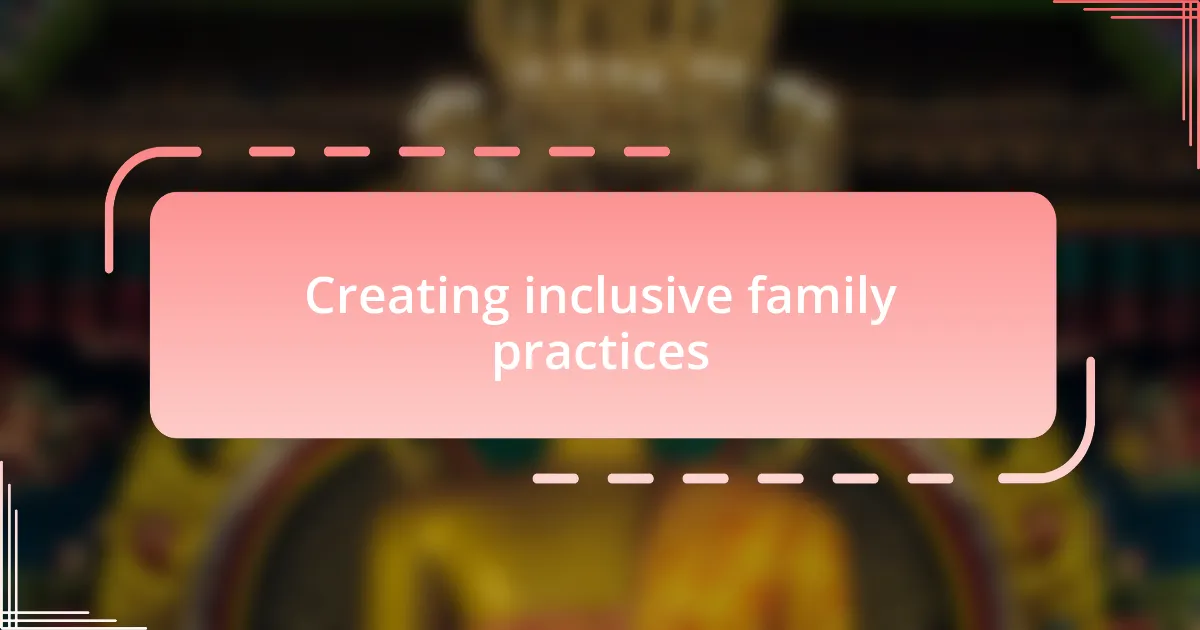
Creating inclusive family practices
Creating inclusive family practices requires intentionality and an openness to adapt. One of my favorite practices emerged when we created a family “celebration calendar.” This simple idea not only honored both faiths by marking key holidays but also included secular milestones that mattered to each family member. I remember the first time we gathered around the table to fill it out. The laughter and joy as our kids identified days they wanted to celebrate made it clear that inclusion fosters connection.
In moments of disagreement, I find it’s essential to lean into open dialogue. For instance, there was a time when my partner and I differed on whether to observe a religious observance or a secular holiday. Instead of viewing it as a conflict, we sat down with our kids and invited them into the conversation. Hearing their perspectives often revealed just how much they cherished both sides of their heritage. Why not empower our children to voice their thoughts and be an integral part of the decision-making process?
Rituals like family dinners can serve as a powerful symbol of inclusivity. I introduced a tradition of “cultural dish nights,” where we prepare meals from both backgrounds. I remember the first time we made matzo ball soup and lasagna side by side. The kitchen was a delightful mess, but more importantly, it became a space of learning and laughter. It’s incredible how food can bridge divides and create a shared experience that celebrates our unique identities. How could anyone not feel a sense of belonging when surrounded by the love of shared meals?

Personal experiences in interfaith education
Navigating interfaith education has been a journey filled with both challenges and revelations. I vividly recall a family discussion about introducing our children to religious texts from both faiths. As I explained the stories from each tradition, I could see their eyes light up with curiosity. It was a moment of unity as they began to grasp the common themes of love and respect, bridging the gaps that might have seemed insurmountable.
One memorable experience was attending a community interfaith event with my family. There, we engaged with families from various backgrounds, sharing insights about our traditions. I was struck by how, despite our different rituals and beliefs, the fundamental values of compassion and kindness resonated universally. This encounter made me reflect: how can we learn from one another and grow together in this diverse tapestry of belief?
It’s during the quieter moments—like reading bedtime stories that reflect both our faiths—that I truly appreciate the beauty of interfaith education. One night, as my child asked, “Mom, why do we celebrate different things?” I felt a wave of gratitude. It was a reminder that these questions are stepping stones, leading to a deeper understanding of our rich, intertwined heritage. Isn’t that the essence of education—teaching our children to appreciate the world’s complexities?
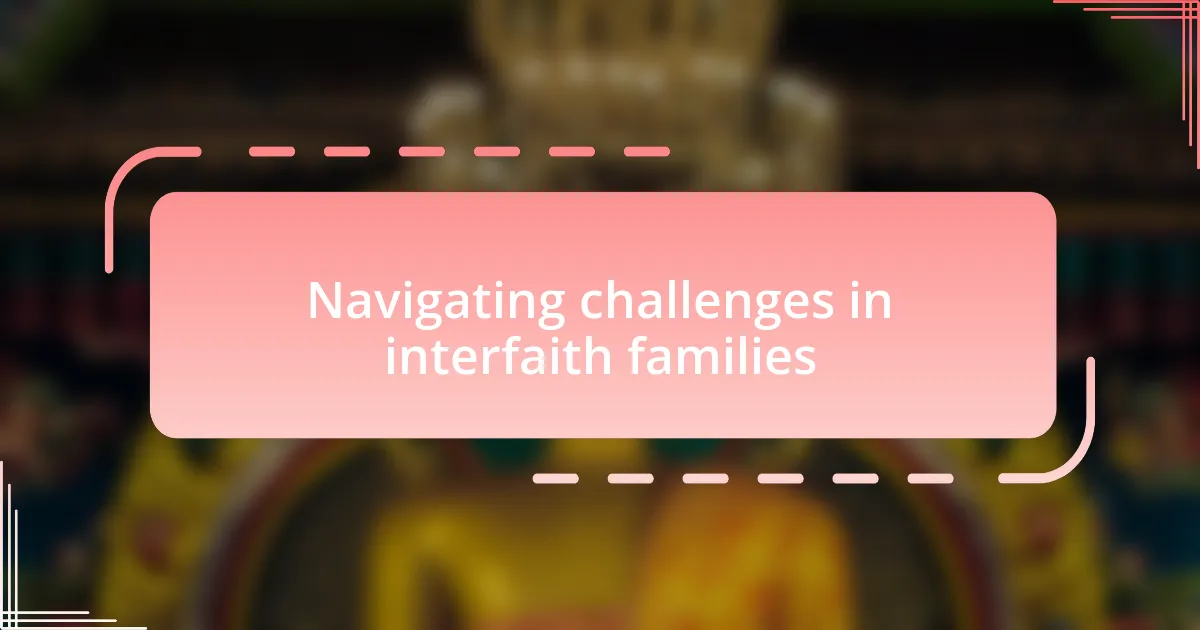
Navigating challenges in interfaith families
Navigating the challenges of an interfaith family often revolves around teaching our children the importance of respect and understanding. I remember a particularly challenging dinner when my child asked, “Why can’t we just pick one faith?” It was an emotional moment for me, as I saw him grappling with the idea of dual identities. Instead of dismissing his concerns, I chose to share how both faiths provide a unique lens through which we can view the world.
One of the hardest parts has been managing the expectations of extended family. I recall a holiday gathering where my in-laws questioned our decision to celebrate traditions from both faiths. It felt like a tightrope walk, balancing respect for their beliefs while standing firm in our family’s values. In that moment, I realized the importance of open dialogue and even invited them to participate in our interfaith practices, showing that inclusion can be a powerful tool in bridging differences.
As with any family dynamic, finding common ground is key. I once suggested we create our own interfaith rituals, blending elements from both traditions. This sparked a delightful conversation about what values mattered most to us. It was heartening to see my partner and I collaborating, turning challenges into shared experiences. Ultimately, this journey has taught me that the richness of our family lies in our ability to learn from each other and grow together.